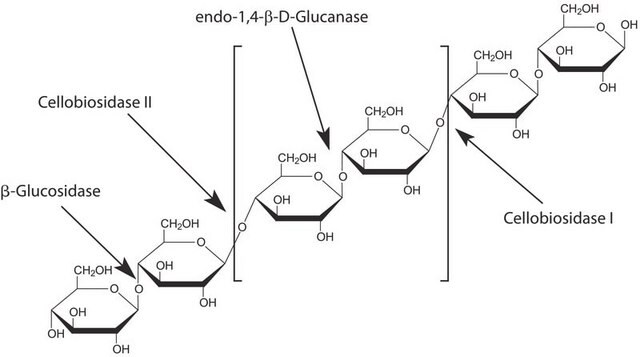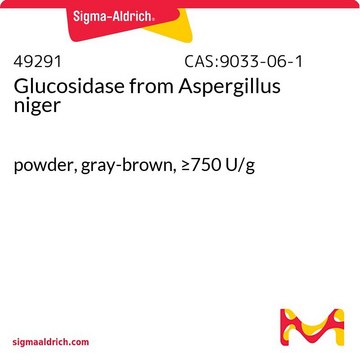Key Documents
C2730
Cellulase from Trichoderma reesei
aqueous solution, ≥700 units/g
Synonim(y):
Celluclast®, Celluclast® 1.5L
About This Item
Polecane produkty
pochodzenie biologiczne
fungus (Trichoderma reesei)
Poziom jakości
Postać
aqueous solution
aktywność właściwa
≥700 units/g
masa cząsteczkowa
68 kDa
charakterystyka ekologicznej alternatywy
Waste Prevention
Design for Energy Efficiency
Learn more about the Principles of Green Chemistry.
sustainability
Greener Alternative Product
gęstość
1.10-1.30 g/mL
kategoria ekologicznej alternatywy
temp. przechowywania
2-8°C
Szukasz podobnych produktów? Odwiedź Przewodnik dotyczący porównywania produktów
Powiązane kategorie
Opis ogólny
Cellulase from Trichoderma reesei is produced by submerged fermentation of a selected strain of the fungus Trichoderma reesei and catalyzes the breakdown of cellulose into glucose, cellobiose, and higher glucose polymers. It corresponds to a molecular mass of 68 kDa with optimum pH and temperature of 6 and 52° C, respectively.
Zastosowanie
- for aqueous extraction of oil from corn germ
- in the enzymatic hydrolysis of Sweet Sorghum Bagasse (SSB)
- in the enzymatic digestion of paper grids
Działania biochem./fizjol.
Informacje prawne
Hasło ostrzegawcze
Danger
Zwroty wskazujące rodzaj zagrożenia
Zwroty wskazujące środki ostrożności
Klasyfikacja zagrożeń
Resp. Sens. 1
Kod klasy składowania
10 - Combustible liquids
Klasa zagrożenia wodnego (WGK)
WGK 1
Temperatura zapłonu (°F)
Not applicable
Temperatura zapłonu (°C)
Not applicable
Środki ochrony indywidualnej
dust mask type N95 (US), Eyeshields, Faceshields, Gloves
Certyfikaty analizy (CoA)
Poszukaj Certyfikaty analizy (CoA), wpisując numer partii/serii produktów. Numery serii i partii można znaleźć na etykiecie produktu po słowach „seria” lub „partia”.
Masz już ten produkt?
Dokumenty związane z niedawno zakupionymi produktami zostały zamieszczone w Bibliotece dokumentów.
Klienci oglądali również te produkty
Nasz zespół naukowców ma doświadczenie we wszystkich obszarach badań, w tym w naukach przyrodniczych, materiałoznawstwie, syntezie chemicznej, chromatografii, analityce i wielu innych dziedzinach.
Skontaktuj się z zespołem ds. pomocy technicznej










